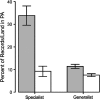Protected areas facilitate species' range expansions
- PMID: 22893689
- PMCID: PMC3435229
- DOI: 10.1073/pnas.1210251109
Protected areas facilitate species' range expansions
Abstract
The benefits of protected areas (PAs) for biodiversity have been questioned in the context of climate change because PAs are static, whereas the distributions of species are dynamic. Current PAs may, however, continue to be important if they provide suitable locations for species to colonize at their leading-edge range boundaries, thereby enabling spread into new regions. Here, we present an empirical assessment of the role of PAs as targets for colonization during recent range expansions. Records from intensive surveys revealed that seven bird and butterfly species have colonized PAs 4.2 (median) times more frequently than expected from the availability of PAs in the landscapes colonized. Records of an additional 256 invertebrate species with less-intensive surveys supported these findings and showed that 98% of species are disproportionately associated with PAs in newly colonized parts of their ranges. Although colonizing species favor PAs in general, species vary greatly in their reliance on PAs, reflecting differences in the dependence of individual species on particular habitats and other conditions that are available only in PAs. These findings highlight the importance of current PAs for facilitating range expansions and show that a small subset of the landscape receives a high proportion of colonizations by range-expanding species.
Conflict of interest statement
The authors declare no conflict of interest.
Figures




References
-
- Soutullo A. Extent of the global network of terrestrial protected areas. Conserv Biol. 2010;24:362–363. - PubMed
-
- Convention on Biological Diversity 2010. Decision Adopted by the Conference of the Parties to the Convention of Biological Diversity at its Tenth meeting. Available at http://www.cbd.int/doc/decisions/COP-10/cop-10-dec-02-en.pdf. Accessed June, 2011.
-
- Harrop SR. Living in harmony with nature? Outcomes of the 2010 Nagoya Conference of the Convention on Biodiversity. J Environ Law. 2011;23:117–128.
-
- Parmesan C, Yohe G. A globally coherent fingerprint of climate change impacts across natural systems. Nature. 2003;421:37–42. - PubMed
Publication types
MeSH terms
LinkOut - more resources
Full Text Sources
Other Literature Sources
Molecular Biology Databases

